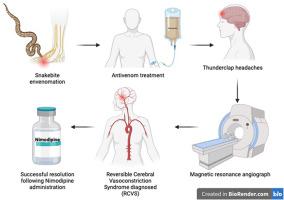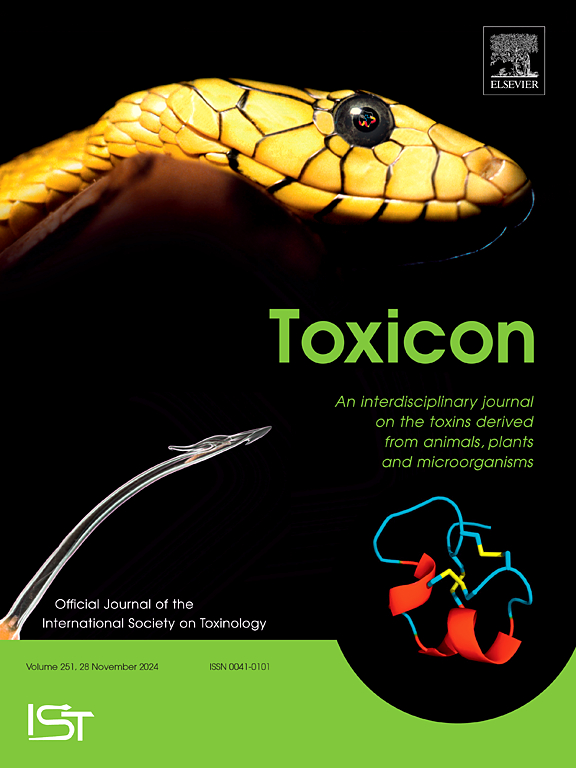蛇咬伤诱发的可逆性脑血管收缩综合征:三例病例报告。
IF 2.6
4区 医学
Q2 PHARMACOLOGY & PHARMACY
引用次数: 0
摘要
被罗素蝰蛇咬伤通常会导致局部组织损伤和出血并发症,但被普通甲蛇和眼镜蛇咬伤主要会导致神经中毒。虽然大多数症状都可以通过适当的抗蛇毒血清来治疗,但一些被蛇咬伤的患者还需要额外的支持,以应对咬伤后出现的各种异常并发症。以脑动脉收缩为特征的可逆性血管收缩综合征(RCVS)是一种罕见但严重的问题,表现为剧烈头痛,极端情况下还会导致出血性/缺血性中风。本报告介绍了三例被罗素蝰、眼镜蛇和乌梢蛇咬伤的蛇伤患者的 RCVS 病例。患者因神经系统和/或血液系统并发症入院,并接受了多价抗蛇毒血清治疗。抗蛇毒血清治疗两天后,所有患者都出现了持续数小时的剧烈头痛,且对常用镇痛药无效。虽然体格检查、实验室检查和计算机断层扫描检查均正常,但通过多模态磁共振血管造影术确诊为 RCVS。所有患者均成功接受了口服尼莫地平治疗,在随访期间,体格检查和实验室检查均无异常,磁共振成像证实 RCVS 已逆转。为了使患者获得良好的治疗效果,临床医生必须迅速识别这种罕见的并发症,并做出准确诊断,提供及时治疗。总之,本报告介绍了蛇咬伤患者罕见的 RCVS 并发症,以及应对这种情况的适当诊断和治疗方法。本文章由计算机程序翻译,如有差异,请以英文原文为准。

Snakebite-induced reversible cerebral vasoconstriction syndrome: Report of three cases
Envenomings from Russell's viper typically result in local tissue damage and bleeding complications, but the bites from common krait and cobra primarily cause neurotoxic effects. While most symptoms can be treated with appropriate antivenom, additional support is necessary for several snakebite victims to tackle a broad range of unusual complications that they develop following bites. Reversible vasoconstriction syndrome (RCVS), characterised by the constriction of cerebral arteries, is a rare but serious issue, presenting with severe headaches and, in extreme cases, haemorrhagic/ischaemic stroke. This report presents three cases of RCVS in snakebite victims following Russell's viper, krait and cobra bites. The patients were admitted to the hospital with neurological and/or haematological complications, and they were treated with polyvalent antivenom. After two days of antivenom treatment, all the patients developed intense headaches that lasted for several hours and failed to respond to commonly used analgesics. While the physical, laboratory and computed tomography examinations were normal, the RCVS was diagnosed with multimodal magnetic resonance angiography. All patients were successfully treated with oral nimodipine, and during their follow-ups, physical and laboratory examinations were unremarkable, and the magnetic resonance imaging confirmed the reversal of RCVS. To achieve positive outcomes in patients, clinicians must swiftly identify such rare complications and make accurate diagnoses to provide prompt treatments. Overall, this report presents an unusual complication of RCVS in snakebite patients and appropriate diagnosis and treatment approaches to tackle this condition.
求助全文
通过发布文献求助,成功后即可免费获取论文全文。
去求助
来源期刊

Toxicon
医学-毒理学
CiteScore
4.80
自引率
10.70%
发文量
358
审稿时长
68 days
期刊介绍:
Toxicon has an open access mirror Toxicon: X, sharing the same aims and scope, editorial team, submission system and rigorous peer review. An introductory offer Toxicon: X - full waiver of the Open Access fee.
Toxicon''s "aims and scope" are to publish:
-articles containing the results of original research on problems related to toxins derived from animals, plants and microorganisms
-papers on novel findings related to the chemical, pharmacological, toxicological, and immunological properties of natural toxins
-molecular biological studies of toxins and other genes from poisonous and venomous organisms that advance understanding of the role or function of toxins
-clinical observations on poisoning and envenoming where a new therapeutic principle has been proposed or a decidedly superior clinical result has been obtained.
-material on the use of toxins as tools in studying biological processes and material on subjects related to venom and antivenom problems.
-articles on the translational application of toxins, for example as drugs and insecticides
-epidemiological studies on envenoming or poisoning, so long as they highlight a previously unrecognised medical problem or provide insight into the prevention or medical treatment of envenoming or poisoning. Retrospective surveys of hospital records, especially those lacking species identification, will not be considered for publication. Properly designed prospective community-based surveys are strongly encouraged.
-articles describing well-known activities of venoms, such as antibacterial, anticancer, and analgesic activities of arachnid venoms, without any attempt to define the mechanism of action or purify the active component, will not be considered for publication in Toxicon.
-review articles on problems related to toxinology.
To encourage the exchange of ideas, sections of the journal may be devoted to Short Communications, Letters to the Editor and activities of the affiliated societies.
 求助内容:
求助内容: 应助结果提醒方式:
应助结果提醒方式:


